Venture Capital Analysis Report: Smart Home Project Finance Overview
VerifiedAdded on 2019/11/12
|33
|6163
|284
Report
AI Summary
This report provides a comprehensive analysis of venture capital, focusing on financial tools, project economic analysis, and the development of financial models for smart home construction projects. It begins with a literature review covering capital budgeting, sources of funds, and weighted average cost of capital. The report then details methodologies for evaluating smart home projects, including cash flow analysis, risk assessment, and the preparation of financial statements such as sales budgets, projected income statements, and cash flow statements. Furthermore, the report examines loan finance conditions, eligibility criteria, and documentation requirements, alongside an overview of equity finance and financial risk considerations. The analysis employs various financial tools, including NPV, IRR, and sensitivity analysis, to assess project viability and guide investment decisions. The report concludes by synthesizing the impact of various financing tools and methodologies on reducing the overall cost of capital and optimizing fund allocation within the venture capital context. Finally, it includes a detailed financial model for smart home construction, incorporating assumptions, constraints, and risk analysis to provide a practical framework for evaluating project feasibility.

RUNNING HEAD: Venture capital analysis 1
Name of the student-
Title-Venture capital analysis
University name-
Name of the student-
Title-Venture capital analysis
University name-
Paraphrase This Document
Need a fresh take? Get an instant paraphrase of this document with our AI Paraphraser
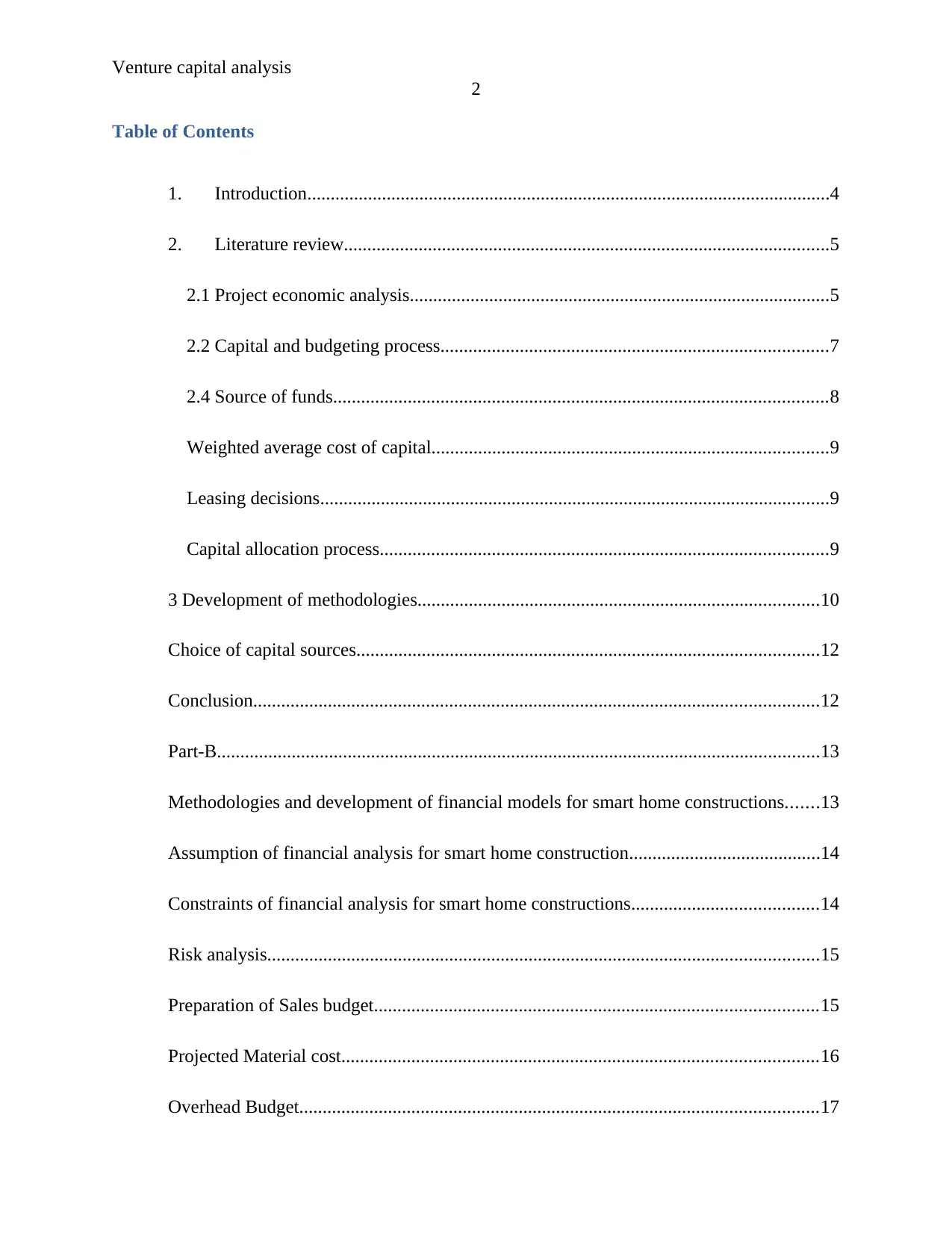
Venture capital analysis
2
Table of Contents
1. Introduction................................................................................................................4
2. Literature review........................................................................................................5
2.1 Project economic analysis..........................................................................................5
2.2 Capital and budgeting process...................................................................................7
2.4 Source of funds..........................................................................................................8
Weighted average cost of capital.....................................................................................9
Leasing decisions.............................................................................................................9
Capital allocation process................................................................................................9
3 Development of methodologies......................................................................................10
Choice of capital sources...................................................................................................12
Conclusion.........................................................................................................................12
Part-B.................................................................................................................................13
Methodologies and development of financial models for smart home constructions.......13
Assumption of financial analysis for smart home construction.........................................14
Constraints of financial analysis for smart home constructions........................................14
Risk analysis......................................................................................................................15
Preparation of Sales budget...............................................................................................15
Projected Material cost......................................................................................................16
Overhead Budget...............................................................................................................17
2
Table of Contents
1. Introduction................................................................................................................4
2. Literature review........................................................................................................5
2.1 Project economic analysis..........................................................................................5
2.2 Capital and budgeting process...................................................................................7
2.4 Source of funds..........................................................................................................8
Weighted average cost of capital.....................................................................................9
Leasing decisions.............................................................................................................9
Capital allocation process................................................................................................9
3 Development of methodologies......................................................................................10
Choice of capital sources...................................................................................................12
Conclusion.........................................................................................................................12
Part-B.................................................................................................................................13
Methodologies and development of financial models for smart home constructions.......13
Assumption of financial analysis for smart home construction.........................................14
Constraints of financial analysis for smart home constructions........................................14
Risk analysis......................................................................................................................15
Preparation of Sales budget...............................................................................................15
Projected Material cost......................................................................................................16
Overhead Budget...............................................................................................................17
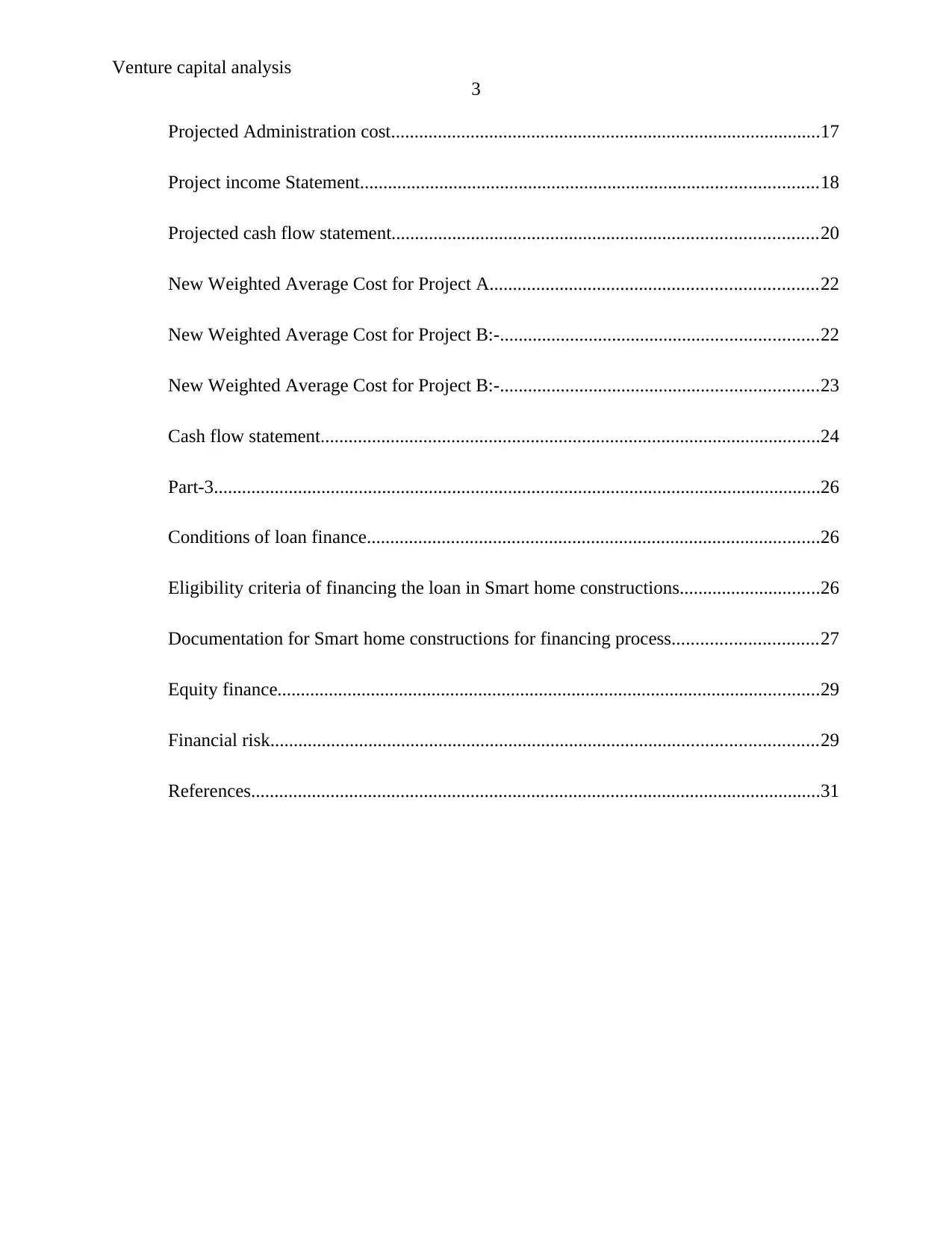
Venture capital analysis
3
Projected Administration cost............................................................................................17
Project income Statement..................................................................................................18
Projected cash flow statement...........................................................................................20
New Weighted Average Cost for Project A......................................................................22
New Weighted Average Cost for Project B:-....................................................................22
New Weighted Average Cost for Project B:-....................................................................23
Cash flow statement...........................................................................................................24
Part-3..................................................................................................................................26
Conditions of loan finance.................................................................................................26
Eligibility criteria of financing the loan in Smart home constructions..............................26
Documentation for Smart home constructions for financing process...............................27
Equity finance....................................................................................................................29
Financial risk.....................................................................................................................29
References..........................................................................................................................31
3
Projected Administration cost............................................................................................17
Project income Statement..................................................................................................18
Projected cash flow statement...........................................................................................20
New Weighted Average Cost for Project A......................................................................22
New Weighted Average Cost for Project B:-....................................................................22
New Weighted Average Cost for Project B:-....................................................................23
Cash flow statement...........................................................................................................24
Part-3..................................................................................................................................26
Conditions of loan finance.................................................................................................26
Eligibility criteria of financing the loan in Smart home constructions..............................26
Documentation for Smart home constructions for financing process...............................27
Equity finance....................................................................................................................29
Financial risk.....................................................................................................................29
References..........................................................................................................................31
⊘ This is a preview!⊘
Do you want full access?
Subscribe today to unlock all pages.

Trusted by 1+ million students worldwide
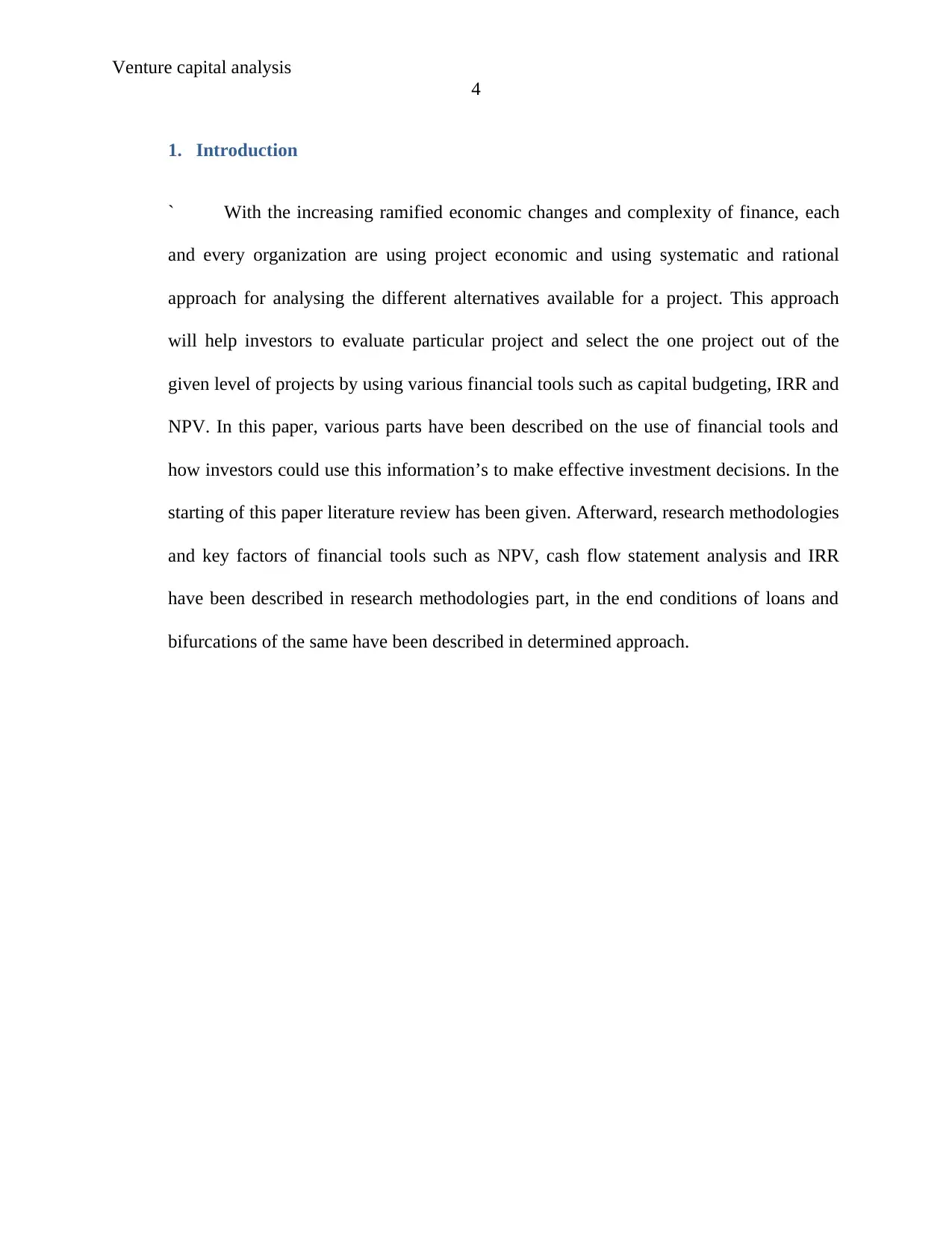
Venture capital analysis
4
1. Introduction
` With the increasing ramified economic changes and complexity of finance, each
and every organization are using project economic and using systematic and rational
approach for analysing the different alternatives available for a project. This approach
will help investors to evaluate particular project and select the one project out of the
given level of projects by using various financial tools such as capital budgeting, IRR and
NPV. In this paper, various parts have been described on the use of financial tools and
how investors could use this information’s to make effective investment decisions. In the
starting of this paper literature review has been given. Afterward, research methodologies
and key factors of financial tools such as NPV, cash flow statement analysis and IRR
have been described in research methodologies part, in the end conditions of loans and
bifurcations of the same have been described in determined approach.
4
1. Introduction
` With the increasing ramified economic changes and complexity of finance, each
and every organization are using project economic and using systematic and rational
approach for analysing the different alternatives available for a project. This approach
will help investors to evaluate particular project and select the one project out of the
given level of projects by using various financial tools such as capital budgeting, IRR and
NPV. In this paper, various parts have been described on the use of financial tools and
how investors could use this information’s to make effective investment decisions. In the
starting of this paper literature review has been given. Afterward, research methodologies
and key factors of financial tools such as NPV, cash flow statement analysis and IRR
have been described in research methodologies part, in the end conditions of loans and
bifurcations of the same have been described in determined approach.
Paraphrase This Document
Need a fresh take? Get an instant paraphrase of this document with our AI Paraphraser
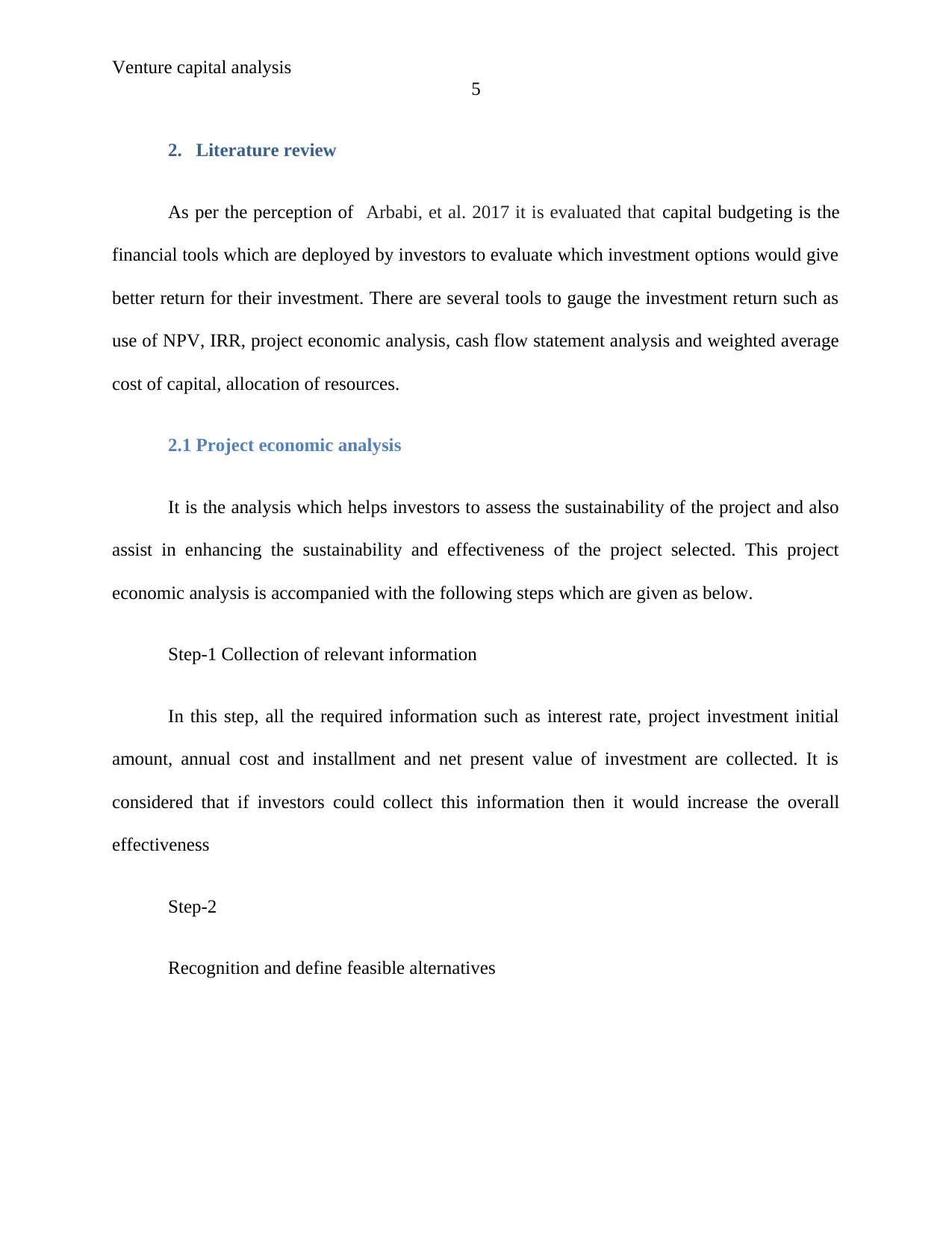
Venture capital analysis
5
2. Literature review
As per the perception of Arbabi, et al. 2017 it is evaluated that capital budgeting is the
financial tools which are deployed by investors to evaluate which investment options would give
better return for their investment. There are several tools to gauge the investment return such as
use of NPV, IRR, project economic analysis, cash flow statement analysis and weighted average
cost of capital, allocation of resources.
2.1 Project economic analysis
It is the analysis which helps investors to assess the sustainability of the project and also
assist in enhancing the sustainability and effectiveness of the project selected. This project
economic analysis is accompanied with the following steps which are given as below.
Step-1 Collection of relevant information
In this step, all the required information such as interest rate, project investment initial
amount, annual cost and installment and net present value of investment are collected. It is
considered that if investors could collect this information then it would increase the overall
effectiveness
Step-2
Recognition and define feasible alternatives
5
2. Literature review
As per the perception of Arbabi, et al. 2017 it is evaluated that capital budgeting is the
financial tools which are deployed by investors to evaluate which investment options would give
better return for their investment. There are several tools to gauge the investment return such as
use of NPV, IRR, project economic analysis, cash flow statement analysis and weighted average
cost of capital, allocation of resources.
2.1 Project economic analysis
It is the analysis which helps investors to assess the sustainability of the project and also
assist in enhancing the sustainability and effectiveness of the project selected. This project
economic analysis is accompanied with the following steps which are given as below.
Step-1 Collection of relevant information
In this step, all the required information such as interest rate, project investment initial
amount, annual cost and installment and net present value of investment are collected. It is
considered that if investors could collect this information then it would increase the overall
effectiveness
Step-2
Recognition and define feasible alternatives
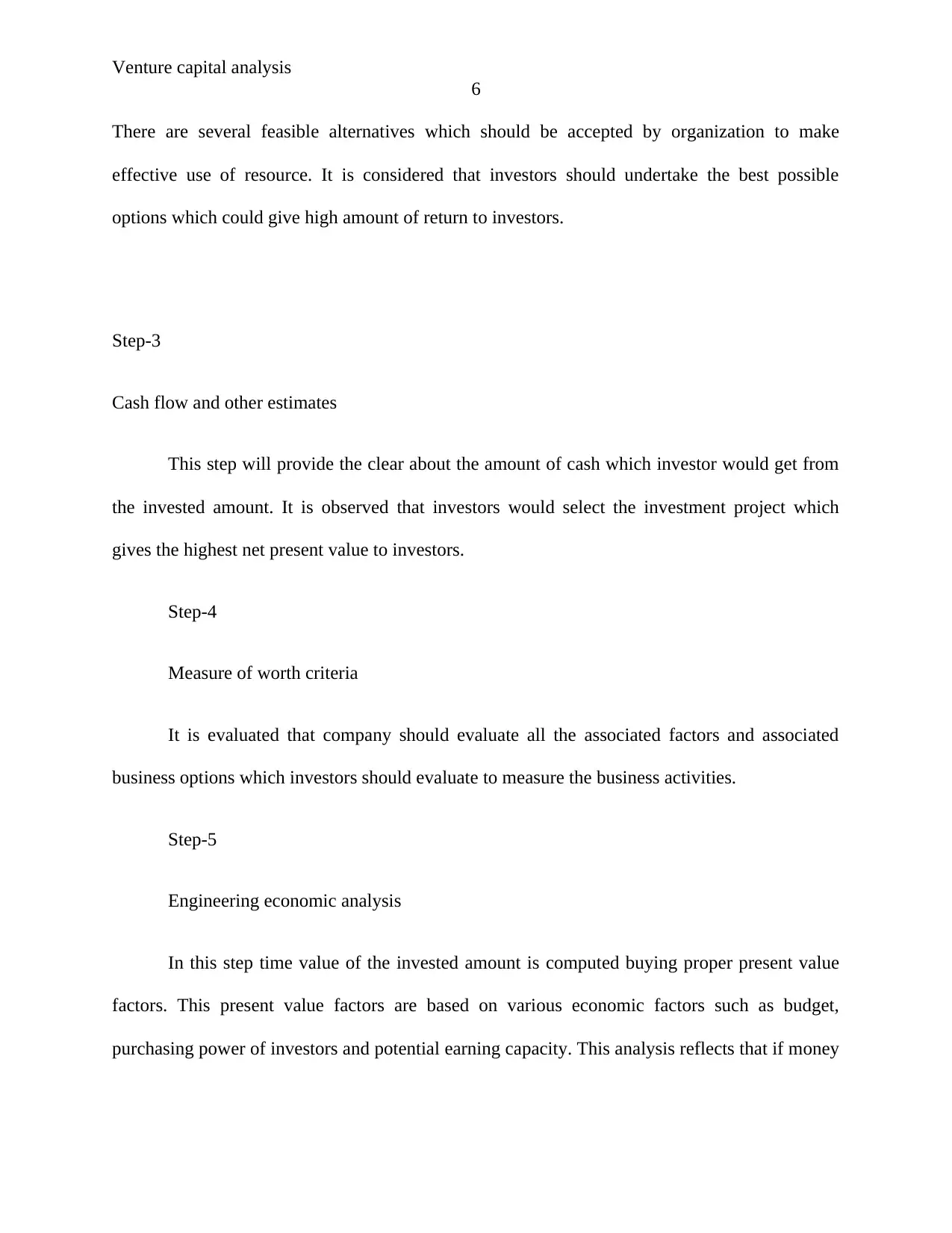
Venture capital analysis
6
There are several feasible alternatives which should be accepted by organization to make
effective use of resource. It is considered that investors should undertake the best possible
options which could give high amount of return to investors.
Step-3
Cash flow and other estimates
This step will provide the clear about the amount of cash which investor would get from
the invested amount. It is observed that investors would select the investment project which
gives the highest net present value to investors.
Step-4
Measure of worth criteria
It is evaluated that company should evaluate all the associated factors and associated
business options which investors should evaluate to measure the business activities.
Step-5
Engineering economic analysis
In this step time value of the invested amount is computed buying proper present value
factors. This present value factors are based on various economic factors such as budget,
purchasing power of investors and potential earning capacity. This analysis reflects that if money
6
There are several feasible alternatives which should be accepted by organization to make
effective use of resource. It is considered that investors should undertake the best possible
options which could give high amount of return to investors.
Step-3
Cash flow and other estimates
This step will provide the clear about the amount of cash which investor would get from
the invested amount. It is observed that investors would select the investment project which
gives the highest net present value to investors.
Step-4
Measure of worth criteria
It is evaluated that company should evaluate all the associated factors and associated
business options which investors should evaluate to measure the business activities.
Step-5
Engineering economic analysis
In this step time value of the invested amount is computed buying proper present value
factors. This present value factors are based on various economic factors such as budget,
purchasing power of investors and potential earning capacity. This analysis reflects that if money
⊘ This is a preview!⊘
Do you want full access?
Subscribe today to unlock all pages.

Trusted by 1+ million students worldwide
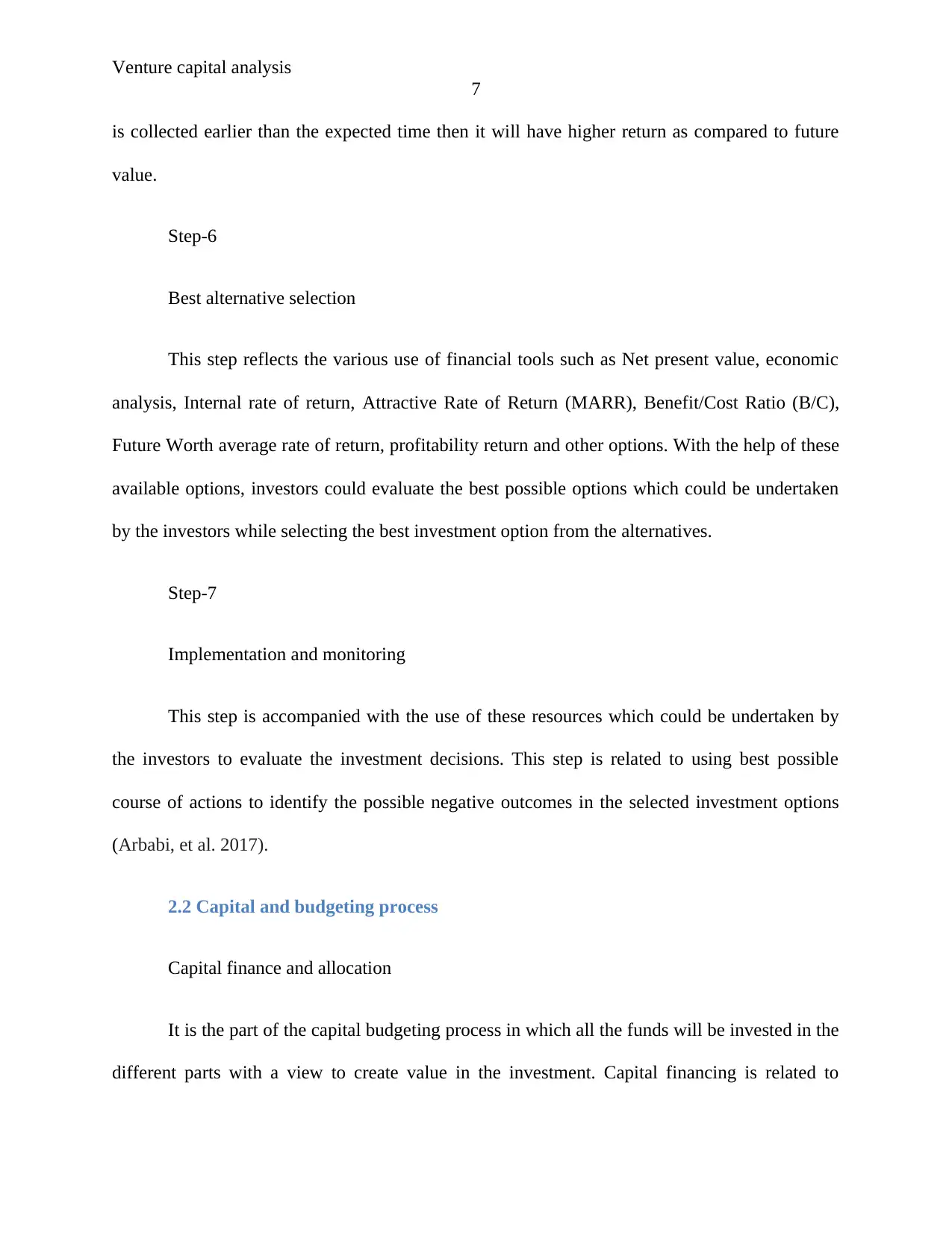
Venture capital analysis
7
is collected earlier than the expected time then it will have higher return as compared to future
value.
Step-6
Best alternative selection
This step reflects the various use of financial tools such as Net present value, economic
analysis, Internal rate of return, Attractive Rate of Return (MARR), Benefit/Cost Ratio (B/C),
Future Worth average rate of return, profitability return and other options. With the help of these
available options, investors could evaluate the best possible options which could be undertaken
by the investors while selecting the best investment option from the alternatives.
Step-7
Implementation and monitoring
This step is accompanied with the use of these resources which could be undertaken by
the investors to evaluate the investment decisions. This step is related to using best possible
course of actions to identify the possible negative outcomes in the selected investment options
(Arbabi, et al. 2017).
2.2 Capital and budgeting process
Capital finance and allocation
It is the part of the capital budgeting process in which all the funds will be invested in the
different parts with a view to create value in the investment. Capital financing is related to
7
is collected earlier than the expected time then it will have higher return as compared to future
value.
Step-6
Best alternative selection
This step reflects the various use of financial tools such as Net present value, economic
analysis, Internal rate of return, Attractive Rate of Return (MARR), Benefit/Cost Ratio (B/C),
Future Worth average rate of return, profitability return and other options. With the help of these
available options, investors could evaluate the best possible options which could be undertaken
by the investors while selecting the best investment option from the alternatives.
Step-7
Implementation and monitoring
This step is accompanied with the use of these resources which could be undertaken by
the investors to evaluate the investment decisions. This step is related to using best possible
course of actions to identify the possible negative outcomes in the selected investment options
(Arbabi, et al. 2017).
2.2 Capital and budgeting process
Capital finance and allocation
It is the part of the capital budgeting process in which all the funds will be invested in the
different parts with a view to create value in the investment. Capital financing is related to
Paraphrase This Document
Need a fresh take? Get an instant paraphrase of this document with our AI Paraphraser
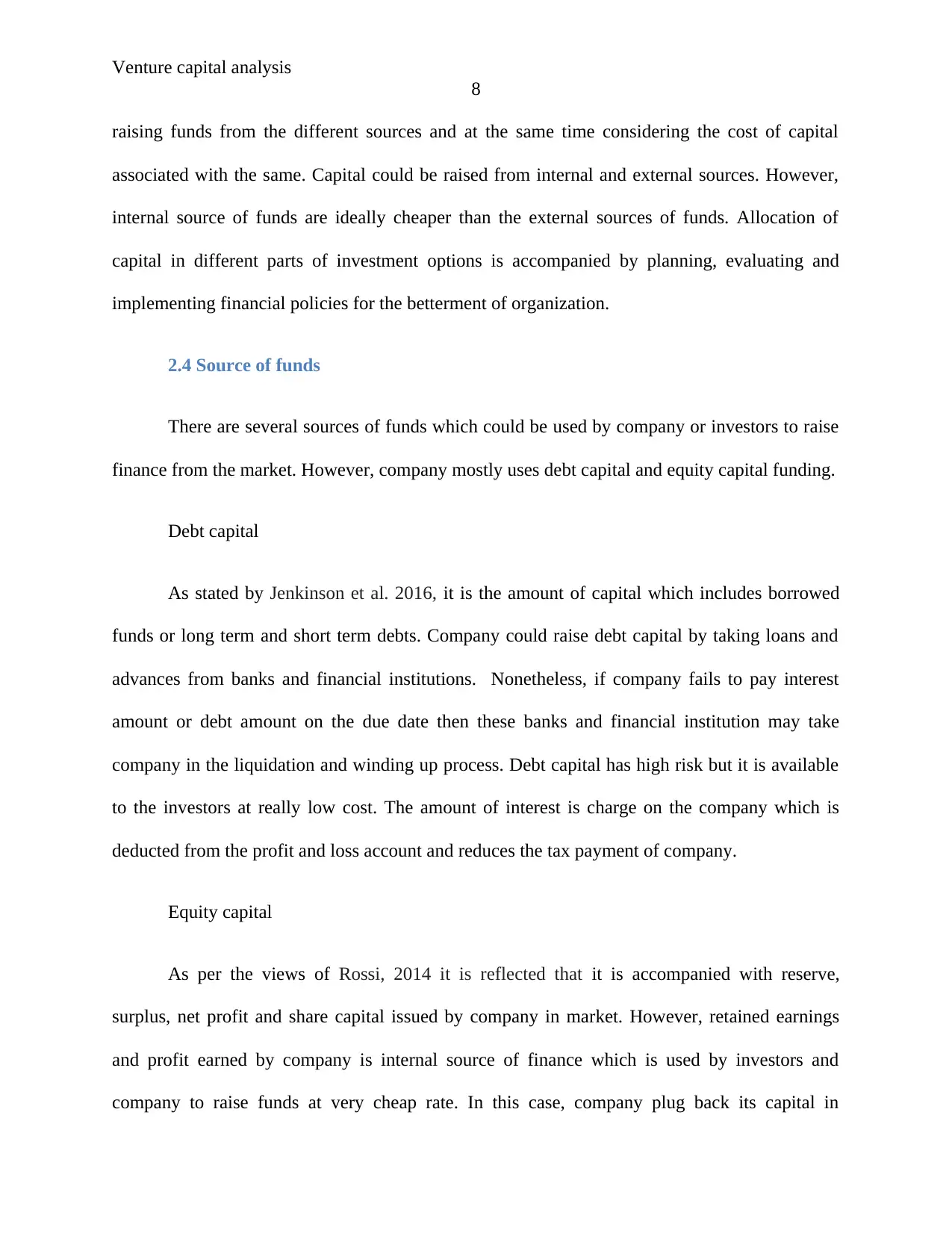
Venture capital analysis
8
raising funds from the different sources and at the same time considering the cost of capital
associated with the same. Capital could be raised from internal and external sources. However,
internal source of funds are ideally cheaper than the external sources of funds. Allocation of
capital in different parts of investment options is accompanied by planning, evaluating and
implementing financial policies for the betterment of organization.
2.4 Source of funds
There are several sources of funds which could be used by company or investors to raise
finance from the market. However, company mostly uses debt capital and equity capital funding.
Debt capital
As stated by Jenkinson et al. 2016, it is the amount of capital which includes borrowed
funds or long term and short term debts. Company could raise debt capital by taking loans and
advances from banks and financial institutions. Nonetheless, if company fails to pay interest
amount or debt amount on the due date then these banks and financial institution may take
company in the liquidation and winding up process. Debt capital has high risk but it is available
to the investors at really low cost. The amount of interest is charge on the company which is
deducted from the profit and loss account and reduces the tax payment of company.
Equity capital
As per the views of Rossi, 2014 it is reflected that it is accompanied with reserve,
surplus, net profit and share capital issued by company in market. However, retained earnings
and profit earned by company is internal source of finance which is used by investors and
company to raise funds at very cheap rate. In this case, company plug back its capital in
8
raising funds from the different sources and at the same time considering the cost of capital
associated with the same. Capital could be raised from internal and external sources. However,
internal source of funds are ideally cheaper than the external sources of funds. Allocation of
capital in different parts of investment options is accompanied by planning, evaluating and
implementing financial policies for the betterment of organization.
2.4 Source of funds
There are several sources of funds which could be used by company or investors to raise
finance from the market. However, company mostly uses debt capital and equity capital funding.
Debt capital
As stated by Jenkinson et al. 2016, it is the amount of capital which includes borrowed
funds or long term and short term debts. Company could raise debt capital by taking loans and
advances from banks and financial institutions. Nonetheless, if company fails to pay interest
amount or debt amount on the due date then these banks and financial institution may take
company in the liquidation and winding up process. Debt capital has high risk but it is available
to the investors at really low cost. The amount of interest is charge on the company which is
deducted from the profit and loss account and reduces the tax payment of company.
Equity capital
As per the views of Rossi, 2014 it is reflected that it is accompanied with reserve,
surplus, net profit and share capital issued by company in market. However, retained earnings
and profit earned by company is internal source of finance which is used by investors and
company to raise funds at very cheap rate. In this case, company plug back its capital in
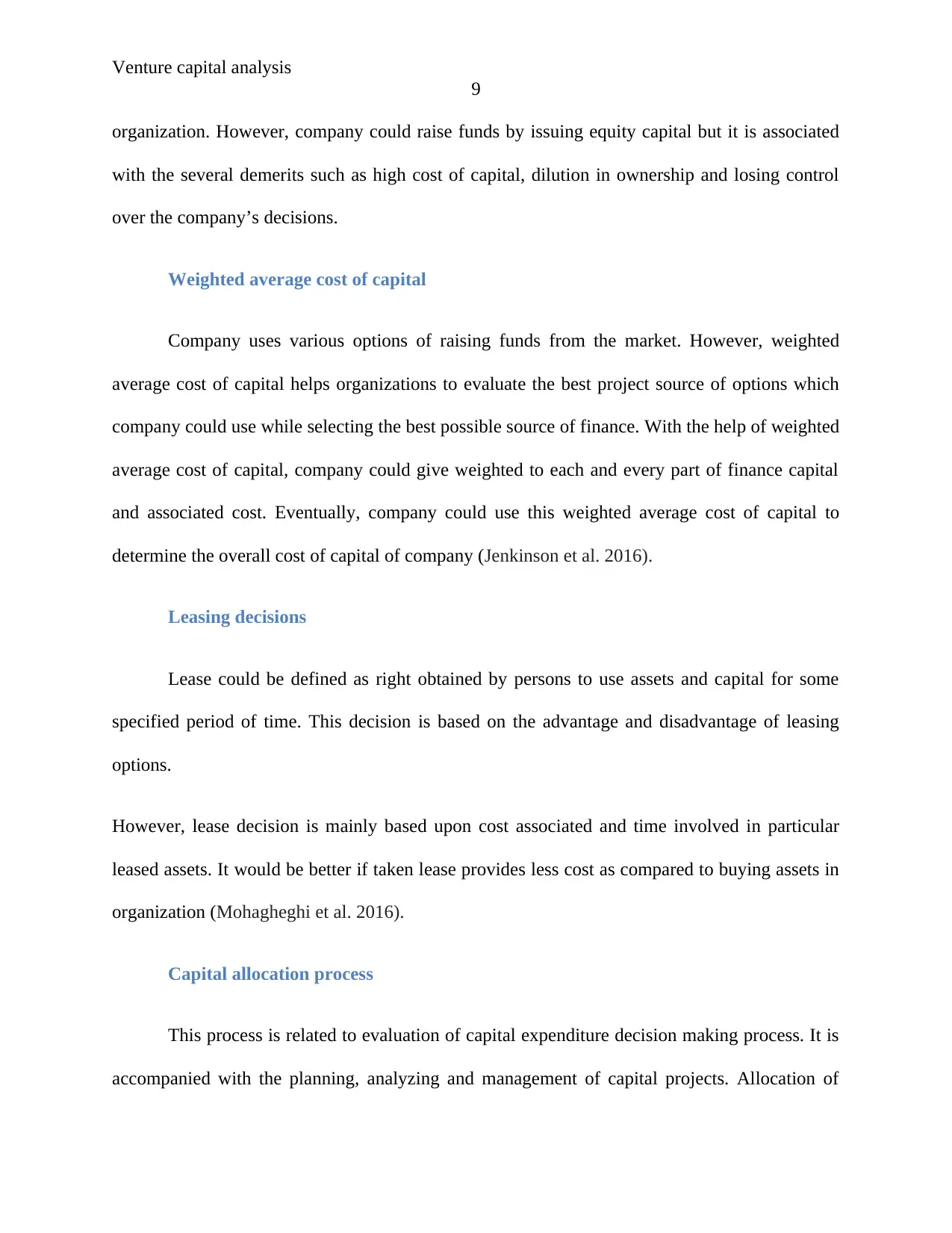
Venture capital analysis
9
organization. However, company could raise funds by issuing equity capital but it is associated
with the several demerits such as high cost of capital, dilution in ownership and losing control
over the company’s decisions.
Weighted average cost of capital
Company uses various options of raising funds from the market. However, weighted
average cost of capital helps organizations to evaluate the best project source of options which
company could use while selecting the best possible source of finance. With the help of weighted
average cost of capital, company could give weighted to each and every part of finance capital
and associated cost. Eventually, company could use this weighted average cost of capital to
determine the overall cost of capital of company (Jenkinson et al. 2016).
Leasing decisions
Lease could be defined as right obtained by persons to use assets and capital for some
specified period of time. This decision is based on the advantage and disadvantage of leasing
options.
However, lease decision is mainly based upon cost associated and time involved in particular
leased assets. It would be better if taken lease provides less cost as compared to buying assets in
organization (Mohagheghi et al. 2016).
Capital allocation process
This process is related to evaluation of capital expenditure decision making process. It is
accompanied with the planning, analyzing and management of capital projects. Allocation of
9
organization. However, company could raise funds by issuing equity capital but it is associated
with the several demerits such as high cost of capital, dilution in ownership and losing control
over the company’s decisions.
Weighted average cost of capital
Company uses various options of raising funds from the market. However, weighted
average cost of capital helps organizations to evaluate the best project source of options which
company could use while selecting the best possible source of finance. With the help of weighted
average cost of capital, company could give weighted to each and every part of finance capital
and associated cost. Eventually, company could use this weighted average cost of capital to
determine the overall cost of capital of company (Jenkinson et al. 2016).
Leasing decisions
Lease could be defined as right obtained by persons to use assets and capital for some
specified period of time. This decision is based on the advantage and disadvantage of leasing
options.
However, lease decision is mainly based upon cost associated and time involved in particular
leased assets. It would be better if taken lease provides less cost as compared to buying assets in
organization (Mohagheghi et al. 2016).
Capital allocation process
This process is related to evaluation of capital expenditure decision making process. It is
accompanied with the planning, analyzing and management of capital projects. Allocation of
⊘ This is a preview!⊘
Do you want full access?
Subscribe today to unlock all pages.

Trusted by 1+ million students worldwide
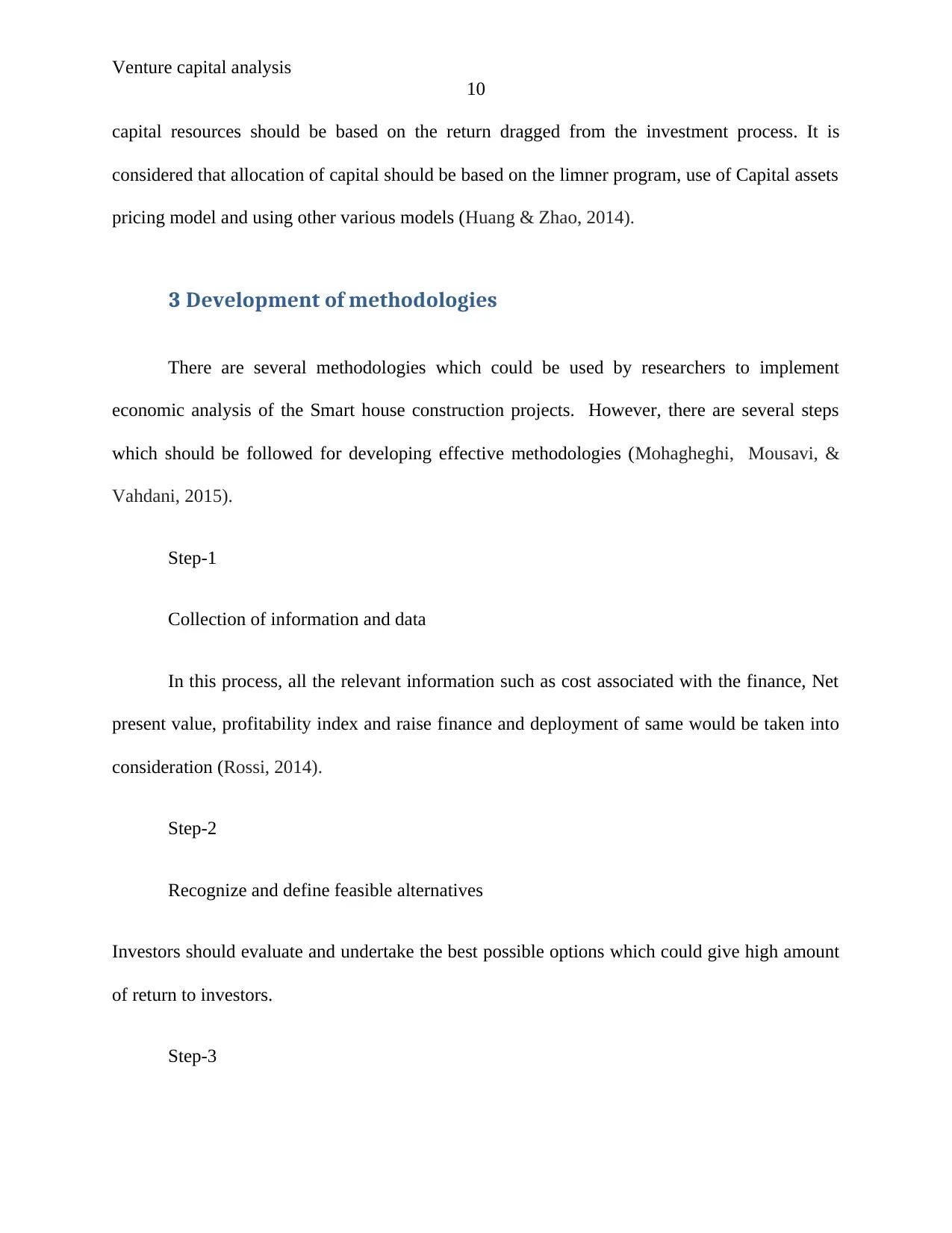
Venture capital analysis
10
capital resources should be based on the return dragged from the investment process. It is
considered that allocation of capital should be based on the limner program, use of Capital assets
pricing model and using other various models (Huang & Zhao, 2014).
3 Development of methodologies
There are several methodologies which could be used by researchers to implement
economic analysis of the Smart house construction projects. However, there are several steps
which should be followed for developing effective methodologies (Mohagheghi, Mousavi, &
Vahdani, 2015).
Step-1
Collection of information and data
In this process, all the relevant information such as cost associated with the finance, Net
present value, profitability index and raise finance and deployment of same would be taken into
consideration (Rossi, 2014).
Step-2
Recognize and define feasible alternatives
Investors should evaluate and undertake the best possible options which could give high amount
of return to investors.
Step-3
10
capital resources should be based on the return dragged from the investment process. It is
considered that allocation of capital should be based on the limner program, use of Capital assets
pricing model and using other various models (Huang & Zhao, 2014).
3 Development of methodologies
There are several methodologies which could be used by researchers to implement
economic analysis of the Smart house construction projects. However, there are several steps
which should be followed for developing effective methodologies (Mohagheghi, Mousavi, &
Vahdani, 2015).
Step-1
Collection of information and data
In this process, all the relevant information such as cost associated with the finance, Net
present value, profitability index and raise finance and deployment of same would be taken into
consideration (Rossi, 2014).
Step-2
Recognize and define feasible alternatives
Investors should evaluate and undertake the best possible options which could give high amount
of return to investors.
Step-3
Paraphrase This Document
Need a fresh take? Get an instant paraphrase of this document with our AI Paraphraser
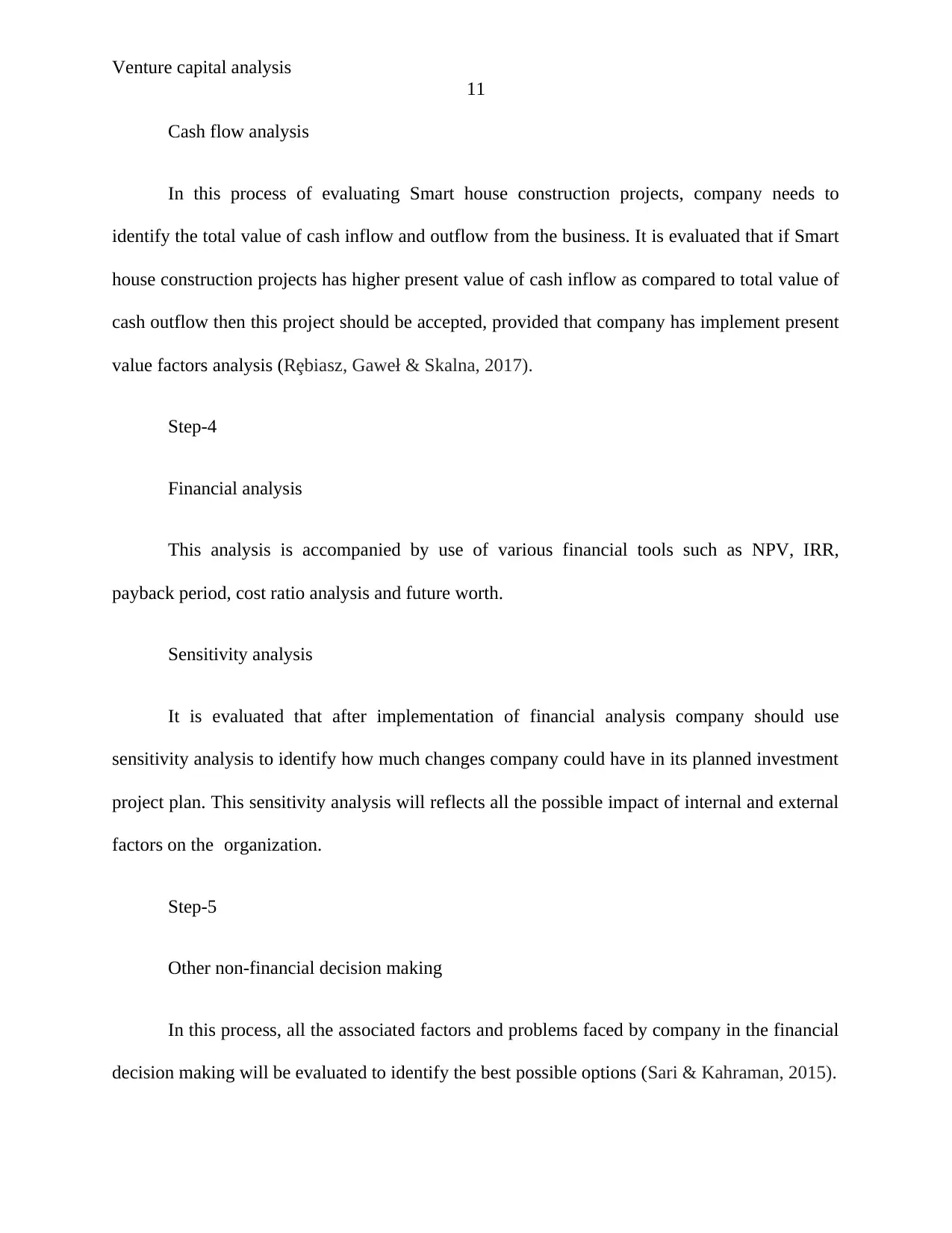
Venture capital analysis
11
Cash flow analysis
In this process of evaluating Smart house construction projects, company needs to
identify the total value of cash inflow and outflow from the business. It is evaluated that if Smart
house construction projects has higher present value of cash inflow as compared to total value of
cash outflow then this project should be accepted, provided that company has implement present
value factors analysis (Rȩbiasz, Gaweł & Skalna, 2017).
Step-4
Financial analysis
This analysis is accompanied by use of various financial tools such as NPV, IRR,
payback period, cost ratio analysis and future worth.
Sensitivity analysis
It is evaluated that after implementation of financial analysis company should use
sensitivity analysis to identify how much changes company could have in its planned investment
project plan. This sensitivity analysis will reflects all the possible impact of internal and external
factors on the organization.
Step-5
Other non-financial decision making
In this process, all the associated factors and problems faced by company in the financial
decision making will be evaluated to identify the best possible options (Sari & Kahraman, 2015).
11
Cash flow analysis
In this process of evaluating Smart house construction projects, company needs to
identify the total value of cash inflow and outflow from the business. It is evaluated that if Smart
house construction projects has higher present value of cash inflow as compared to total value of
cash outflow then this project should be accepted, provided that company has implement present
value factors analysis (Rȩbiasz, Gaweł & Skalna, 2017).
Step-4
Financial analysis
This analysis is accompanied by use of various financial tools such as NPV, IRR,
payback period, cost ratio analysis and future worth.
Sensitivity analysis
It is evaluated that after implementation of financial analysis company should use
sensitivity analysis to identify how much changes company could have in its planned investment
project plan. This sensitivity analysis will reflects all the possible impact of internal and external
factors on the organization.
Step-5
Other non-financial decision making
In this process, all the associated factors and problems faced by company in the financial
decision making will be evaluated to identify the best possible options (Sari & Kahraman, 2015).
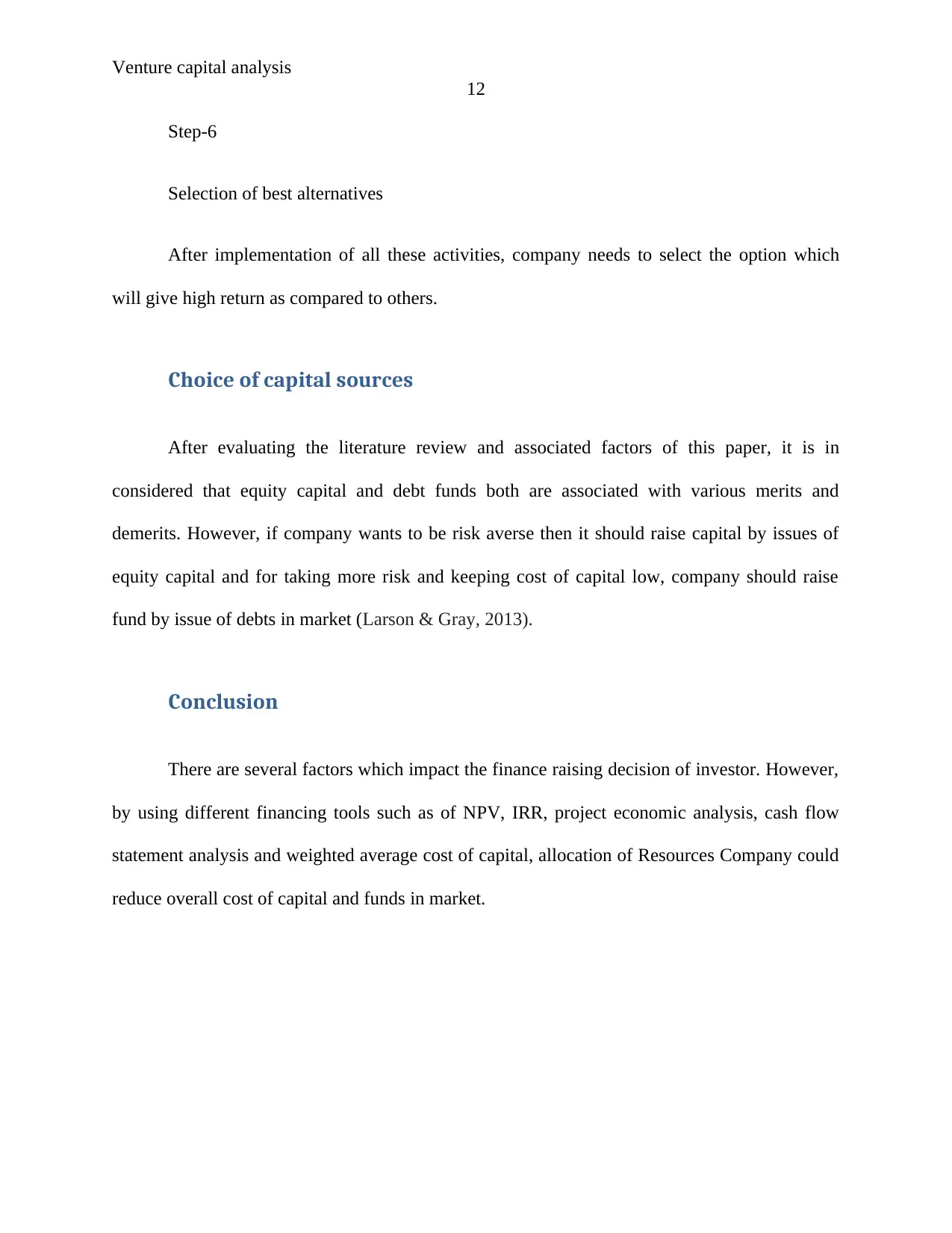
Venture capital analysis
12
Step-6
Selection of best alternatives
After implementation of all these activities, company needs to select the option which
will give high return as compared to others.
Choice of capital sources
After evaluating the literature review and associated factors of this paper, it is in
considered that equity capital and debt funds both are associated with various merits and
demerits. However, if company wants to be risk averse then it should raise capital by issues of
equity capital and for taking more risk and keeping cost of capital low, company should raise
fund by issue of debts in market (Larson & Gray, 2013).
Conclusion
There are several factors which impact the finance raising decision of investor. However,
by using different financing tools such as of NPV, IRR, project economic analysis, cash flow
statement analysis and weighted average cost of capital, allocation of Resources Company could
reduce overall cost of capital and funds in market.
12
Step-6
Selection of best alternatives
After implementation of all these activities, company needs to select the option which
will give high return as compared to others.
Choice of capital sources
After evaluating the literature review and associated factors of this paper, it is in
considered that equity capital and debt funds both are associated with various merits and
demerits. However, if company wants to be risk averse then it should raise capital by issues of
equity capital and for taking more risk and keeping cost of capital low, company should raise
fund by issue of debts in market (Larson & Gray, 2013).
Conclusion
There are several factors which impact the finance raising decision of investor. However,
by using different financing tools such as of NPV, IRR, project economic analysis, cash flow
statement analysis and weighted average cost of capital, allocation of Resources Company could
reduce overall cost of capital and funds in market.
⊘ This is a preview!⊘
Do you want full access?
Subscribe today to unlock all pages.

Trusted by 1+ million students worldwide
1 out of 33
Related Documents
Your All-in-One AI-Powered Toolkit for Academic Success.
+13062052269
info@desklib.com
Available 24*7 on WhatsApp / Email
![[object Object]](/_next/static/media/star-bottom.7253800d.svg)
Unlock your academic potential
Copyright © 2020–2025 A2Z Services. All Rights Reserved. Developed and managed by ZUCOL.




